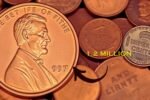A Coin Worth Millions?
The claim that a 1944 steel penny is valued at $9 million and still circulating has sparked excitement among coin enthusiasts, fueled by viral posts on X and sites like basirhatpolice.org. This Lincoln Wheat Penny, a rare error coin from World War II, is said to be a collector’s holy grail due to its scarcity and historical significance. However, no credible evidence supports a $9 million valuation, with top auction records showing a 1944-S steel penny sold for $408,000 in 2021. Let’s dive into the facts behind this sensational claim and explore the 1944 steel penny’s true value.
Why Is It So Rare?
In 1943, the U.S. Mint switched to zinc-coated steel pennies to conserve copper for the war effort, but in 1944, production reverted to copper (95% copper, 5% zinc). A few leftover steel planchets from 1943 were mistakenly struck with the 1944 date, creating an ultra-rare error coin. Estimates suggest only 20-40 such coins exist across Philadelphia (no mint mark), Denver (D), and San Francisco (S) mints, with the 1944-S being the rarest at just two known examples. These coins are magnetic (unlike copper pennies) and weigh 2.7 grams compared to 3.11 grams for copper cents.
True Value & Auction Records
The 1944 steel penny’s value varies by mint mark and condition (graded on the Sheldon scale, 1-70). Here’s a breakdown based on reliable sources:
- 1944-S Steel Penny: Two known, with an MS66 example sold for $408,000 in 2021. Average condition: ~$399,637.
- 1944-D Steel Penny: Seven known, with an MS63 sold for $115,000 in 2007. Average condition: ~$34,000.
- 1944 (No Mint Mark) Steel Penny: ~30 known, with an MS64 sold for $180,000 in 2021. Average condition: ~$28,000.
The $9 million claim, echoed in sources like basirhatpolice.org, lacks substantiation and appears inflated, possibly confusing the 1944 steel penny with the 1943 copper penny, which fetched $1.7 million in 2010. No 1944 steel penny has ever approached $9 million, and claims of such a coin circulating are speculative, as most are likely in collections or identified by dealers.
How to Spot One
If you’re hunting for a 1944 steel penny, here’s how to identify it:
- Magnet Test: Steel pennies stick to magnets; copper pennies don’t.
- Weight: Steel pennies weigh ~2.7 grams; copper pennies weigh ~3.11 grams.
- Appearance: Silvery, zinc-coated steel with a powdery or rusty surface, unlike copper’s reddish-brown hue.
- Mint Mark: Check for “S” (San Francisco), “D” (Denver), or no mark (Philadelphia) below the date.
- Errors: Look for double-die errors (e.g., doubled “IN GOD WE TRUST” or “LIBERTY”), which can boost value into millions, though only one such 1944 steel penny is known.
Could It Still Be Out There?
While it’s theoretically possible a 1944 steel penny remains in circulation, the odds are slim. With only 20-40 known, most are likely in collections, museums, or vaults. The Philadelphia Mint’s production of Belgian steel coins in 1944 explains the error, but these coins were quickly noticed by collectors. X posts fuel the “still circulating” narrative, but experts believe undiscovered examples are rare, likely hidden in old coin jars or inherited collections rather than pocket change. If found, authentication by PCGS or NGC is crucial, as counterfeits exist.
The Real Story
The 1944 steel penny is a numismatic treasure, with top specimens fetching $100,000-$408,000, not $9 million. The $9 million claim seems to stem from exaggerated reports or confusion with other rare coins, like the 1943 copper penny. To check your coins, use a magnet, weigh them, and consult a professional grader. Visit pcgs.com or ngccoin.com for authentication details. While a life-changing find is unlikely, the 1944 steel penny’s history and rarity make it worth a look—your spare change might still hold a fortune



